Overview of the National Construction Code (NCC) and BCA
VerifiedAdded on 2019/10/18
|12
|2838
|1168
Homework Assignment
AI Summary
This document provides a comprehensive overview of the National Construction Code (NCC) and the Building Code of Australia (BCA). It addresses key aspects such as the NCC's purpose, the rationale behind Australian building regulations, and the mandatory parts of the BCA. The assignment explores alternative solutions, deemed-to-satisfy provisions, and their implications in building design. It also covers building classifications, relevant Australian standards, and the performance-based approach of the BCA. Furthermore, the document outlines methods for determining compliance with performance requirements, the objectives of providing light within buildings, and the functional statements for smoke alarms. It also addresses footing requirements, acceptable construction practices for masonry and roof tie-downs, and the level of protection needed for buildings in specific locations. The document serves as a valuable resource for understanding the intricacies of building codes and regulations in Australia.
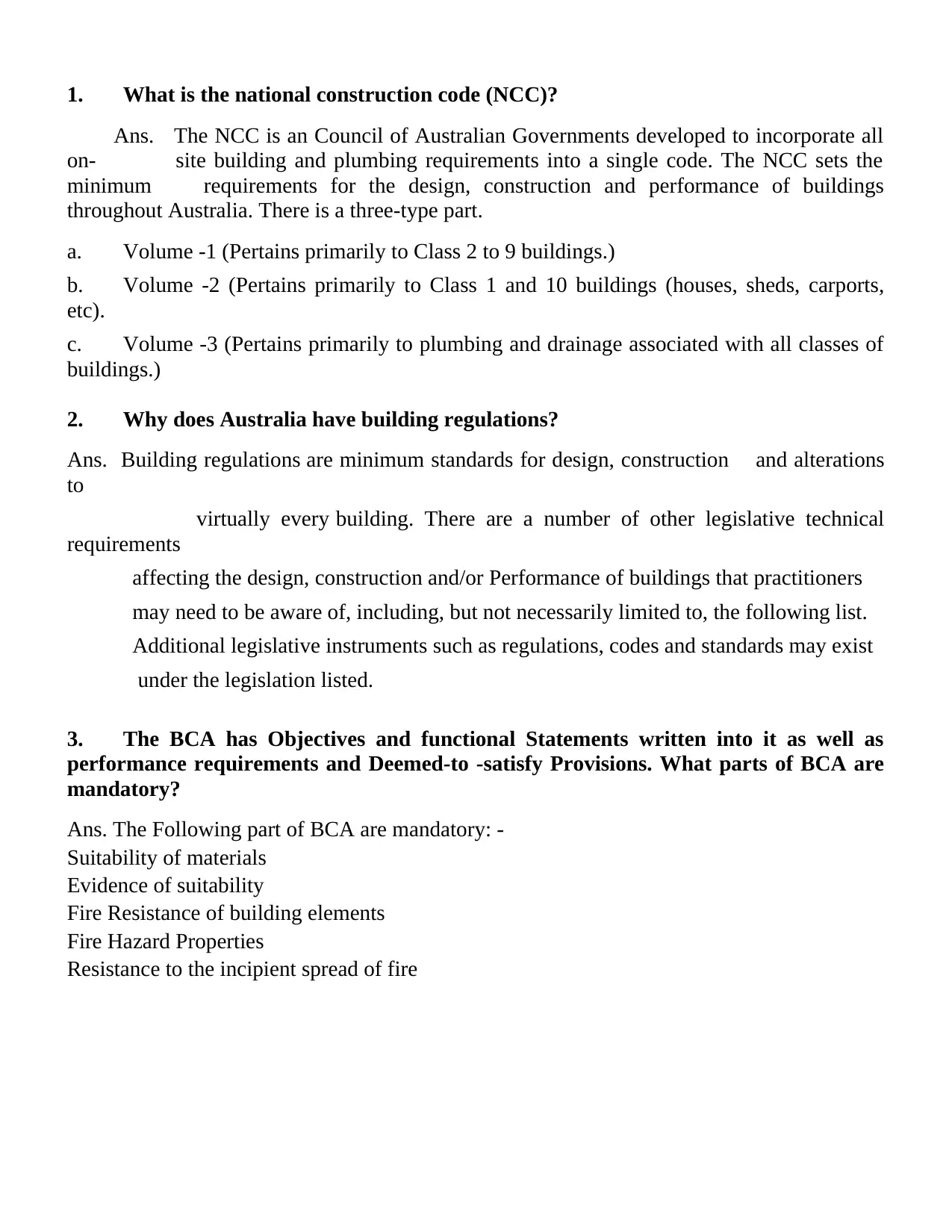
1. What is the national construction code (NCC)?
Ans. The NCC is an Council of Australian Governments developed to incorporate all
on- site building and plumbing requirements into a single code. The NCC sets the
minimum requirements for the design, construction and performance of buildings
throughout Australia. There is a three-type part.
a. Volume -1 (Pertains primarily to Class 2 to 9 buildings.)
b. Volume -2 (Pertains primarily to Class 1 and 10 buildings (houses, sheds, carports,
etc).
c. Volume -3 (Pertains primarily to plumbing and drainage associated with all classes of
buildings.)
2. Why does Australia have building regulations?
Ans. Building regulations are minimum standards for design, construction and alterations
to
virtually every building. There are a number of other legislative technical
requirements
affecting the design, construction and/or Performance of buildings that practitioners
may need to be aware of, including, but not necessarily limited to, the following list.
Additional legislative instruments such as regulations, codes and standards may exist
under the legislation listed.
3. The BCA has Objectives and functional Statements written into it as well as
performance requirements and Deemed-to -satisfy Provisions. What parts of BCA are
mandatory?
Ans. The Following part of BCA are mandatory: -
Suitability of materials
Evidence of suitability
Fire Resistance of building elements
Fire Hazard Properties
Resistance to the incipient spread of fire
Ans. The NCC is an Council of Australian Governments developed to incorporate all
on- site building and plumbing requirements into a single code. The NCC sets the
minimum requirements for the design, construction and performance of buildings
throughout Australia. There is a three-type part.
a. Volume -1 (Pertains primarily to Class 2 to 9 buildings.)
b. Volume -2 (Pertains primarily to Class 1 and 10 buildings (houses, sheds, carports,
etc).
c. Volume -3 (Pertains primarily to plumbing and drainage associated with all classes of
buildings.)
2. Why does Australia have building regulations?
Ans. Building regulations are minimum standards for design, construction and alterations
to
virtually every building. There are a number of other legislative technical
requirements
affecting the design, construction and/or Performance of buildings that practitioners
may need to be aware of, including, but not necessarily limited to, the following list.
Additional legislative instruments such as regulations, codes and standards may exist
under the legislation listed.
3. The BCA has Objectives and functional Statements written into it as well as
performance requirements and Deemed-to -satisfy Provisions. What parts of BCA are
mandatory?
Ans. The Following part of BCA are mandatory: -
Suitability of materials
Evidence of suitability
Fire Resistance of building elements
Fire Hazard Properties
Resistance to the incipient spread of fire
Paraphrase This Document
Need a fresh take? Get an instant paraphrase of this document with our AI Paraphraser
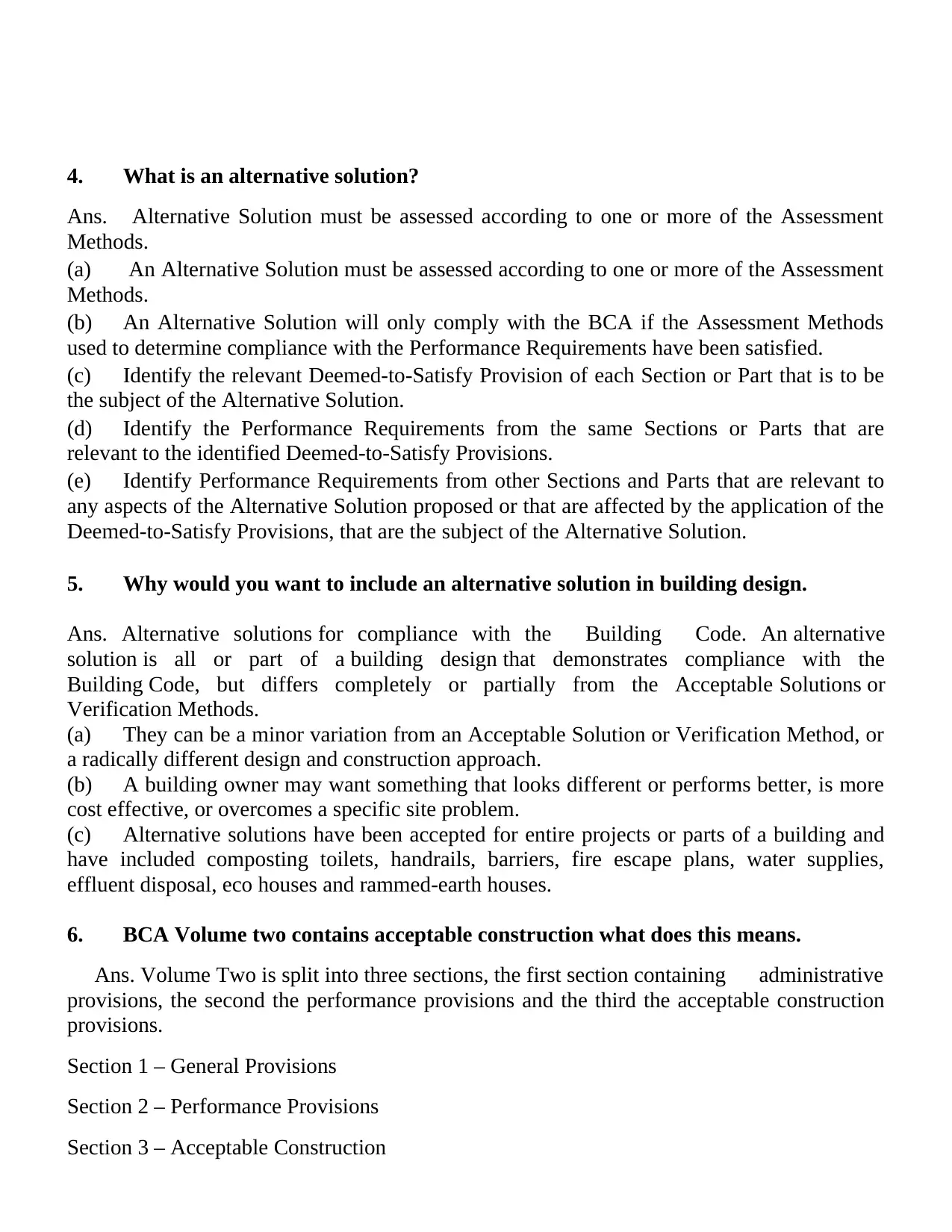
4. What is an alternative solution?
Ans. Alternative Solution must be assessed according to one or more of the Assessment
Methods.
(a) An Alternative Solution must be assessed according to one or more of the Assessment
Methods.
(b) An Alternative Solution will only comply with the BCA if the Assessment Methods
used to determine compliance with the Performance Requirements have been satisfied.
(c) Identify the relevant Deemed-to-Satisfy Provision of each Section or Part that is to be
the subject of the Alternative Solution.
(d) Identify the Performance Requirements from the same Sections or Parts that are
relevant to the identified Deemed-to-Satisfy Provisions.
(e) Identify Performance Requirements from other Sections and Parts that are relevant to
any aspects of the Alternative Solution proposed or that are affected by the application of the
Deemed-to-Satisfy Provisions, that are the subject of the Alternative Solution.
5. Why would you want to include an alternative solution in building design.
Ans. Alternative solutions for compliance with the Building Code. An alternative
solution is all or part of a building design that demonstrates compliance with the
Building Code, but differs completely or partially from the Acceptable Solutions or
Verification Methods.
(a) They can be a minor variation from an Acceptable Solution or Verification Method, or
a radically different design and construction approach.
(b) A building owner may want something that looks different or performs better, is more
cost effective, or overcomes a specific site problem.
(c) Alternative solutions have been accepted for entire projects or parts of a building and
have included composting toilets, handrails, barriers, fire escape plans, water supplies,
effluent disposal, eco houses and rammed-earth houses.
6. BCA Volume two contains acceptable construction what does this means.
Ans. Volume Two is split into three sections, the first section containing administrative
provisions, the second the performance provisions and the third the acceptable construction
provisions.
Section 1 – General Provisions
Section 2 – Performance Provisions
Section 3 – Acceptable Construction
Ans. Alternative Solution must be assessed according to one or more of the Assessment
Methods.
(a) An Alternative Solution must be assessed according to one or more of the Assessment
Methods.
(b) An Alternative Solution will only comply with the BCA if the Assessment Methods
used to determine compliance with the Performance Requirements have been satisfied.
(c) Identify the relevant Deemed-to-Satisfy Provision of each Section or Part that is to be
the subject of the Alternative Solution.
(d) Identify the Performance Requirements from the same Sections or Parts that are
relevant to the identified Deemed-to-Satisfy Provisions.
(e) Identify Performance Requirements from other Sections and Parts that are relevant to
any aspects of the Alternative Solution proposed or that are affected by the application of the
Deemed-to-Satisfy Provisions, that are the subject of the Alternative Solution.
5. Why would you want to include an alternative solution in building design.
Ans. Alternative solutions for compliance with the Building Code. An alternative
solution is all or part of a building design that demonstrates compliance with the
Building Code, but differs completely or partially from the Acceptable Solutions or
Verification Methods.
(a) They can be a minor variation from an Acceptable Solution or Verification Method, or
a radically different design and construction approach.
(b) A building owner may want something that looks different or performs better, is more
cost effective, or overcomes a specific site problem.
(c) Alternative solutions have been accepted for entire projects or parts of a building and
have included composting toilets, handrails, barriers, fire escape plans, water supplies,
effluent disposal, eco houses and rammed-earth houses.
6. BCA Volume two contains acceptable construction what does this means.
Ans. Volume Two is split into three sections, the first section containing administrative
provisions, the second the performance provisions and the third the acceptable construction
provisions.
Section 1 – General Provisions
Section 2 – Performance Provisions
Section 3 – Acceptable Construction
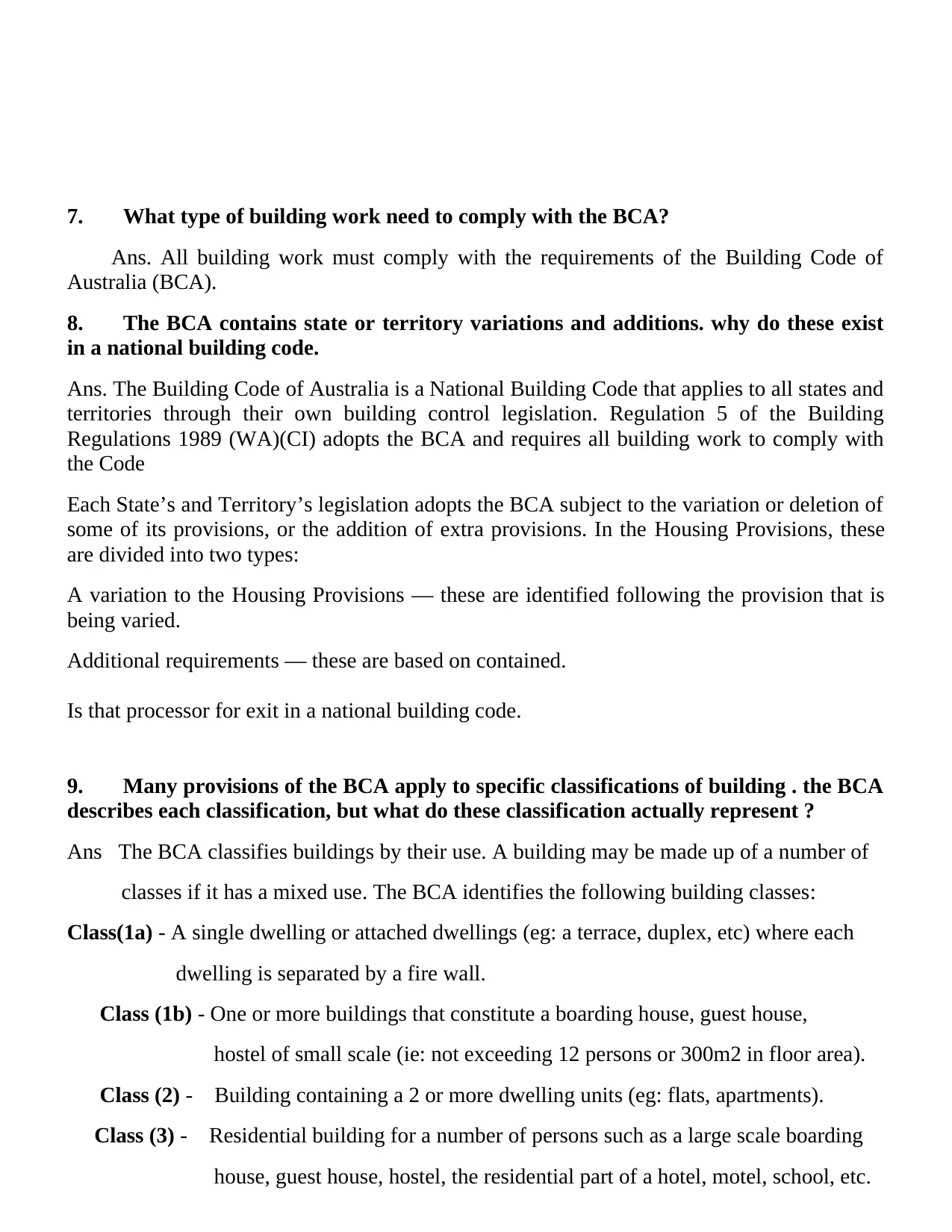
7. What type of building work need to comply with the BCA?
Ans. All building work must comply with the requirements of the Building Code of
Australia (BCA).
8. The BCA contains state or territory variations and additions. why do these exist
in a national building code.
Ans. The Building Code of Australia is a National Building Code that applies to all states and
territories through their own building control legislation. Regulation 5 of the Building
Regulations 1989 (WA)(CI) adopts the BCA and requires all building work to comply with
the Code
Each State’s and Territory’s legislation adopts the BCA subject to the variation or deletion of
some of its provisions, or the addition of extra provisions. In the Housing Provisions, these
are divided into two types:
A variation to the Housing Provisions — these are identified following the provision that is
being varied.
Additional requirements — these are based on contained.
Is that processor for exit in a national building code.
9. Many provisions of the BCA apply to specific classifications of building . the BCA
describes each classification, but what do these classification actually represent ?
Ans The BCA classifies buildings by their use. A building may be made up of a number of
classes if it has a mixed use. The BCA identifies the following building classes:
Class(1a) - A single dwelling or attached dwellings (eg: a terrace, duplex, etc) where each
dwelling is separated by a fire wall.
Class (1b) - One or more buildings that constitute a boarding house, guest house,
hostel of small scale (ie: not exceeding 12 persons or 300m2 in floor area).
Class (2) - Building containing a 2 or more dwelling units (eg: flats, apartments).
Class (3) - Residential building for a number of persons such as a large scale boarding
house, guest house, hostel, the residential part of a hotel, motel, school, etc.
Ans. All building work must comply with the requirements of the Building Code of
Australia (BCA).
8. The BCA contains state or territory variations and additions. why do these exist
in a national building code.
Ans. The Building Code of Australia is a National Building Code that applies to all states and
territories through their own building control legislation. Regulation 5 of the Building
Regulations 1989 (WA)(CI) adopts the BCA and requires all building work to comply with
the Code
Each State’s and Territory’s legislation adopts the BCA subject to the variation or deletion of
some of its provisions, or the addition of extra provisions. In the Housing Provisions, these
are divided into two types:
A variation to the Housing Provisions — these are identified following the provision that is
being varied.
Additional requirements — these are based on contained.
Is that processor for exit in a national building code.
9. Many provisions of the BCA apply to specific classifications of building . the BCA
describes each classification, but what do these classification actually represent ?
Ans The BCA classifies buildings by their use. A building may be made up of a number of
classes if it has a mixed use. The BCA identifies the following building classes:
Class(1a) - A single dwelling or attached dwellings (eg: a terrace, duplex, etc) where each
dwelling is separated by a fire wall.
Class (1b) - One or more buildings that constitute a boarding house, guest house,
hostel of small scale (ie: not exceeding 12 persons or 300m2 in floor area).
Class (2) - Building containing a 2 or more dwelling units (eg: flats, apartments).
Class (3) - Residential building for a number of persons such as a large scale boarding
house, guest house, hostel, the residential part of a hotel, motel, school, etc.
⊘ This is a preview!⊘
Do you want full access?
Subscribe today to unlock all pages.

Trusted by 1+ million students worldwide
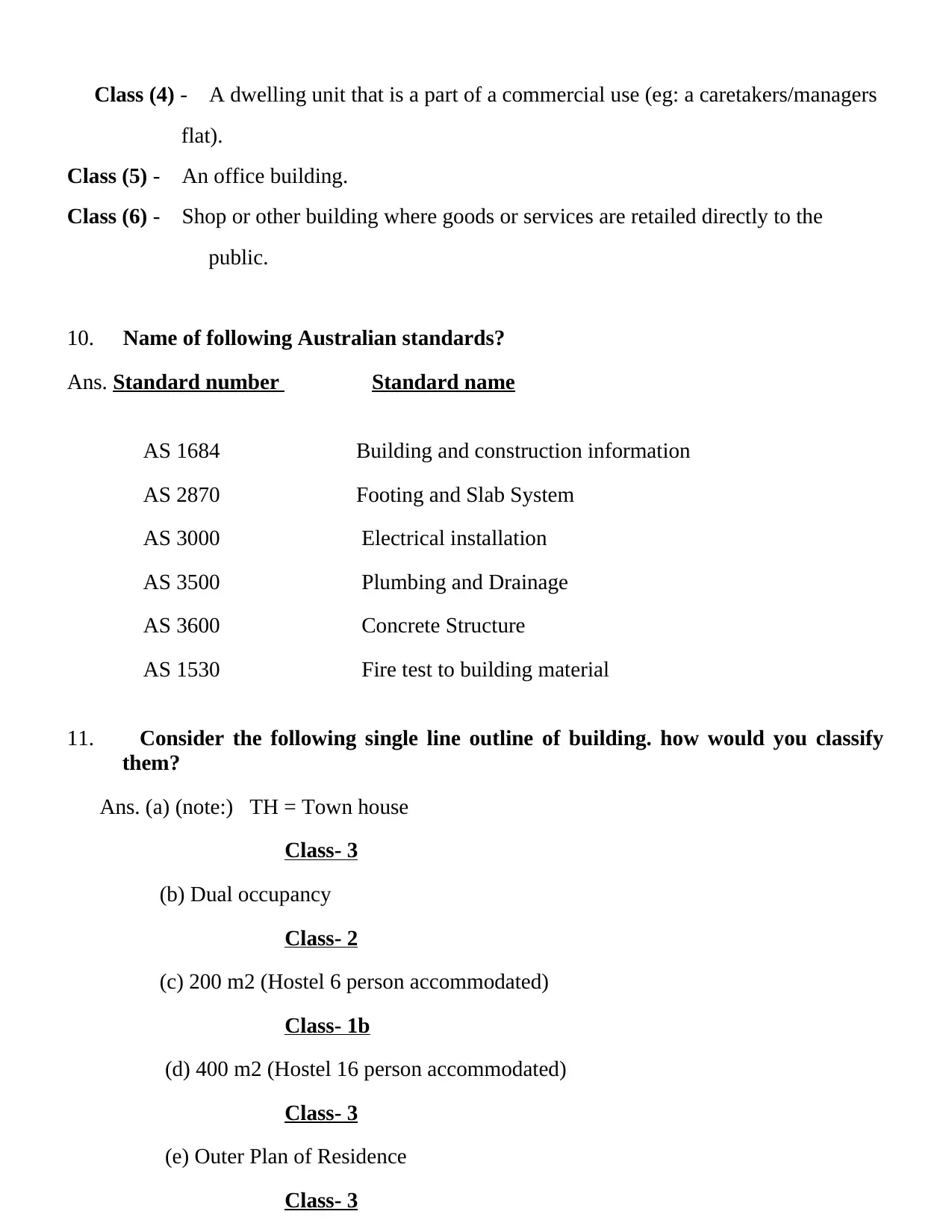
Class (4) - A dwelling unit that is a part of a commercial use (eg: a caretakers/managers
flat).
Class (5) - An office building.
Class (6) - Shop or other building where goods or services are retailed directly to the
public.
10. Name of following Australian standards?
Ans. Standard number Standard name
AS 1684 Building and construction information
AS 2870 Footing and Slab System
AS 3000 Electrical installation
AS 3500 Plumbing and Drainage
AS 3600 Concrete Structure
AS 1530 Fire test to building material
11. Consider the following single line outline of building. how would you classify
them?
Ans. (a) (note:) TH = Town house
Class- 3
(b) Dual occupancy
Class- 2
(c) 200 m2 (Hostel 6 person accommodated)
Class- 1b
(d) 400 m2 (Hostel 16 person accommodated)
Class- 3
(e) Outer Plan of Residence
Class- 3
flat).
Class (5) - An office building.
Class (6) - Shop or other building where goods or services are retailed directly to the
public.
10. Name of following Australian standards?
Ans. Standard number Standard name
AS 1684 Building and construction information
AS 2870 Footing and Slab System
AS 3000 Electrical installation
AS 3500 Plumbing and Drainage
AS 3600 Concrete Structure
AS 1530 Fire test to building material
11. Consider the following single line outline of building. how would you classify
them?
Ans. (a) (note:) TH = Town house
Class- 3
(b) Dual occupancy
Class- 2
(c) 200 m2 (Hostel 6 person accommodated)
Class- 1b
(d) 400 m2 (Hostel 16 person accommodated)
Class- 3
(e) Outer Plan of Residence
Class- 3
Paraphrase This Document
Need a fresh take? Get an instant paraphrase of this document with our AI Paraphraser
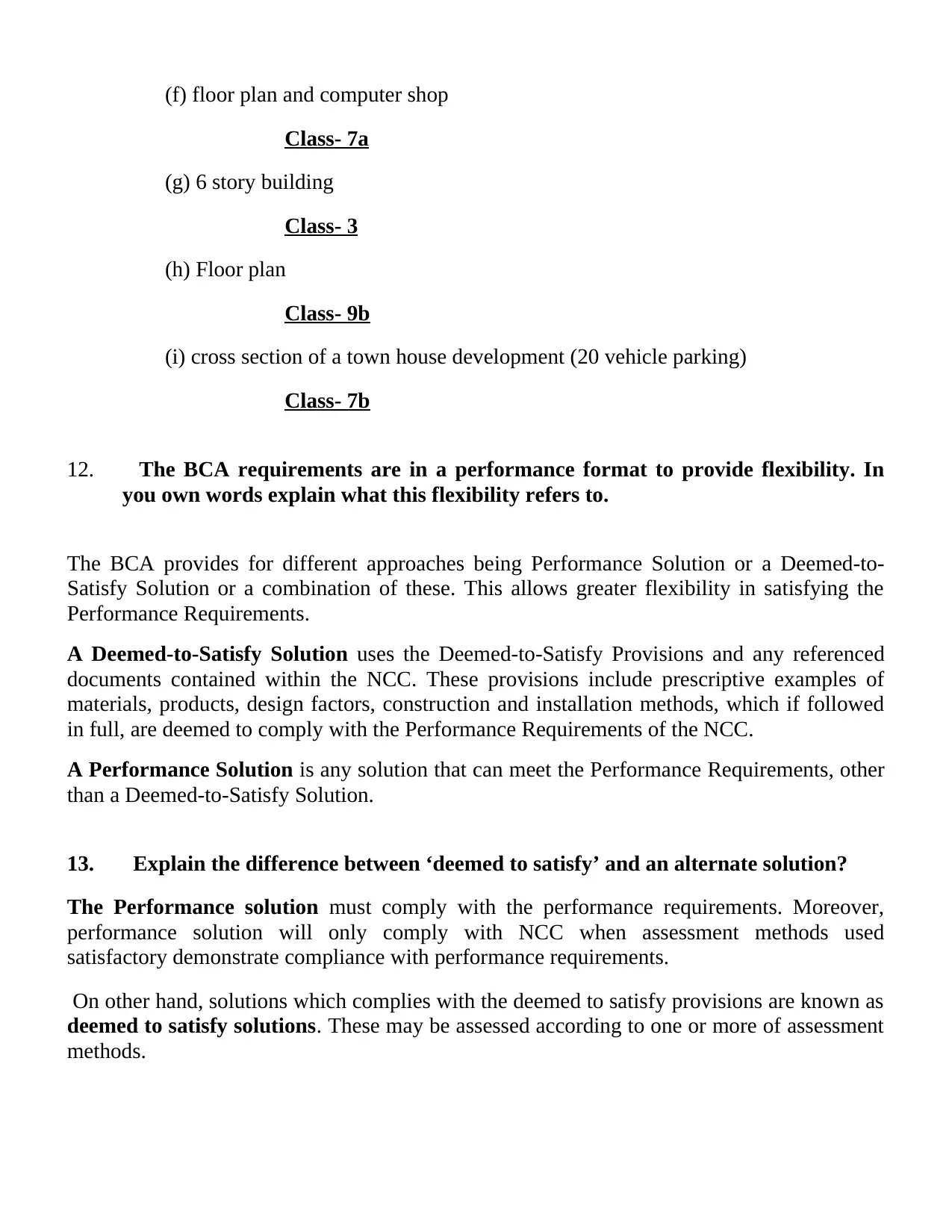
(f) floor plan and computer shop
Class- 7a
(g) 6 story building
Class- 3
(h) Floor plan
Class- 9b
(i) cross section of a town house development (20 vehicle parking)
Class- 7b
12. The BCA requirements are in a performance format to provide flexibility. In
you own words explain what this flexibility refers to.
The BCA provides for different approaches being Performance Solution or a Deemed-to-
Satisfy Solution or a combination of these. This allows greater flexibility in satisfying the
Performance Requirements.
A Deemed-to-Satisfy Solution uses the Deemed-to-Satisfy Provisions and any referenced
documents contained within the NCC. These provisions include prescriptive examples of
materials, products, design factors, construction and installation methods, which if followed
in full, are deemed to comply with the Performance Requirements of the NCC.
A Performance Solution is any solution that can meet the Performance Requirements, other
than a Deemed-to-Satisfy Solution.
13. Explain the difference between ‘deemed to satisfy’ and an alternate solution?
The Performance solution must comply with the performance requirements. Moreover,
performance solution will only comply with NCC when assessment methods used
satisfactory demonstrate compliance with performance requirements.
On other hand, solutions which complies with the deemed to satisfy provisions are known as
deemed to satisfy solutions. These may be assessed according to one or more of assessment
methods.
Class- 7a
(g) 6 story building
Class- 3
(h) Floor plan
Class- 9b
(i) cross section of a town house development (20 vehicle parking)
Class- 7b
12. The BCA requirements are in a performance format to provide flexibility. In
you own words explain what this flexibility refers to.
The BCA provides for different approaches being Performance Solution or a Deemed-to-
Satisfy Solution or a combination of these. This allows greater flexibility in satisfying the
Performance Requirements.
A Deemed-to-Satisfy Solution uses the Deemed-to-Satisfy Provisions and any referenced
documents contained within the NCC. These provisions include prescriptive examples of
materials, products, design factors, construction and installation methods, which if followed
in full, are deemed to comply with the Performance Requirements of the NCC.
A Performance Solution is any solution that can meet the Performance Requirements, other
than a Deemed-to-Satisfy Solution.
13. Explain the difference between ‘deemed to satisfy’ and an alternate solution?
The Performance solution must comply with the performance requirements. Moreover,
performance solution will only comply with NCC when assessment methods used
satisfactory demonstrate compliance with performance requirements.
On other hand, solutions which complies with the deemed to satisfy provisions are known as
deemed to satisfy solutions. These may be assessed according to one or more of assessment
methods.

14. Classification of buildings and structures are found in section 1 of BCA. How is
the classification of building determined?
Ans. Buildings are classified as follows: -
1. Class 1 - Class 1a – single Dwelling house
- Class 1b- boarding house, guest house, hostel
2. Class 2 - building containing 2 or more sole occupancy.
3. Class 3 – a residential building other than building of class 1 or 2.
4. Class 4 – dwelling in building that is class 5,6,7,8 or 9 if it is the only dwelling in
house
5. Class 5 – a office building used for professional or commercial purposes except
buildings of class 6,7,8 or 9.
6. Class 6 – a shop or other building for sale of goods by retail or supply of services.
7. Class 7 – a building which is either a cark park, or for storage, display of goods, etc.
8. Class 8 – A laboratory, or building in which handicraft or process of production or
assembling, altering, repairing is carried on for trade.
9. Class 9 – a building of public nature
- Class 9a – health care building
- Class 9b – Assembly buildings
- Class 9c – An aged care building
10.Class 10 – a non-habitable building
- Class 10a – Private garage, shed
- Class 10b – structure with fence, mast, swimming pool
- Class 9c – Private bushfire shelter.
15. A building Solution can be assessed in different ways. Explain a method of
determining that a building solution complies with performance Requirement.
The following method must be used to determine the Performance Requirement
(a) Where a Performance Requirement is satisfied entirely by a Performance Solution:
(i) Identify the relevant Performance Requirement from the Section or Part to which the
Performance Solution applies.
(ii) Identify Performance Requirements from other Sections or Parts that are relevant to
any aspects of the Performance Solution proposed or that are affected by the application
of the Performance Solution.
the classification of building determined?
Ans. Buildings are classified as follows: -
1. Class 1 - Class 1a – single Dwelling house
- Class 1b- boarding house, guest house, hostel
2. Class 2 - building containing 2 or more sole occupancy.
3. Class 3 – a residential building other than building of class 1 or 2.
4. Class 4 – dwelling in building that is class 5,6,7,8 or 9 if it is the only dwelling in
house
5. Class 5 – a office building used for professional or commercial purposes except
buildings of class 6,7,8 or 9.
6. Class 6 – a shop or other building for sale of goods by retail or supply of services.
7. Class 7 – a building which is either a cark park, or for storage, display of goods, etc.
8. Class 8 – A laboratory, or building in which handicraft or process of production or
assembling, altering, repairing is carried on for trade.
9. Class 9 – a building of public nature
- Class 9a – health care building
- Class 9b – Assembly buildings
- Class 9c – An aged care building
10.Class 10 – a non-habitable building
- Class 10a – Private garage, shed
- Class 10b – structure with fence, mast, swimming pool
- Class 9c – Private bushfire shelter.
15. A building Solution can be assessed in different ways. Explain a method of
determining that a building solution complies with performance Requirement.
The following method must be used to determine the Performance Requirement
(a) Where a Performance Requirement is satisfied entirely by a Performance Solution:
(i) Identify the relevant Performance Requirement from the Section or Part to which the
Performance Solution applies.
(ii) Identify Performance Requirements from other Sections or Parts that are relevant to
any aspects of the Performance Solution proposed or that are affected by the application
of the Performance Solution.
⊘ This is a preview!⊘
Do you want full access?
Subscribe today to unlock all pages.

Trusted by 1+ million students worldwide
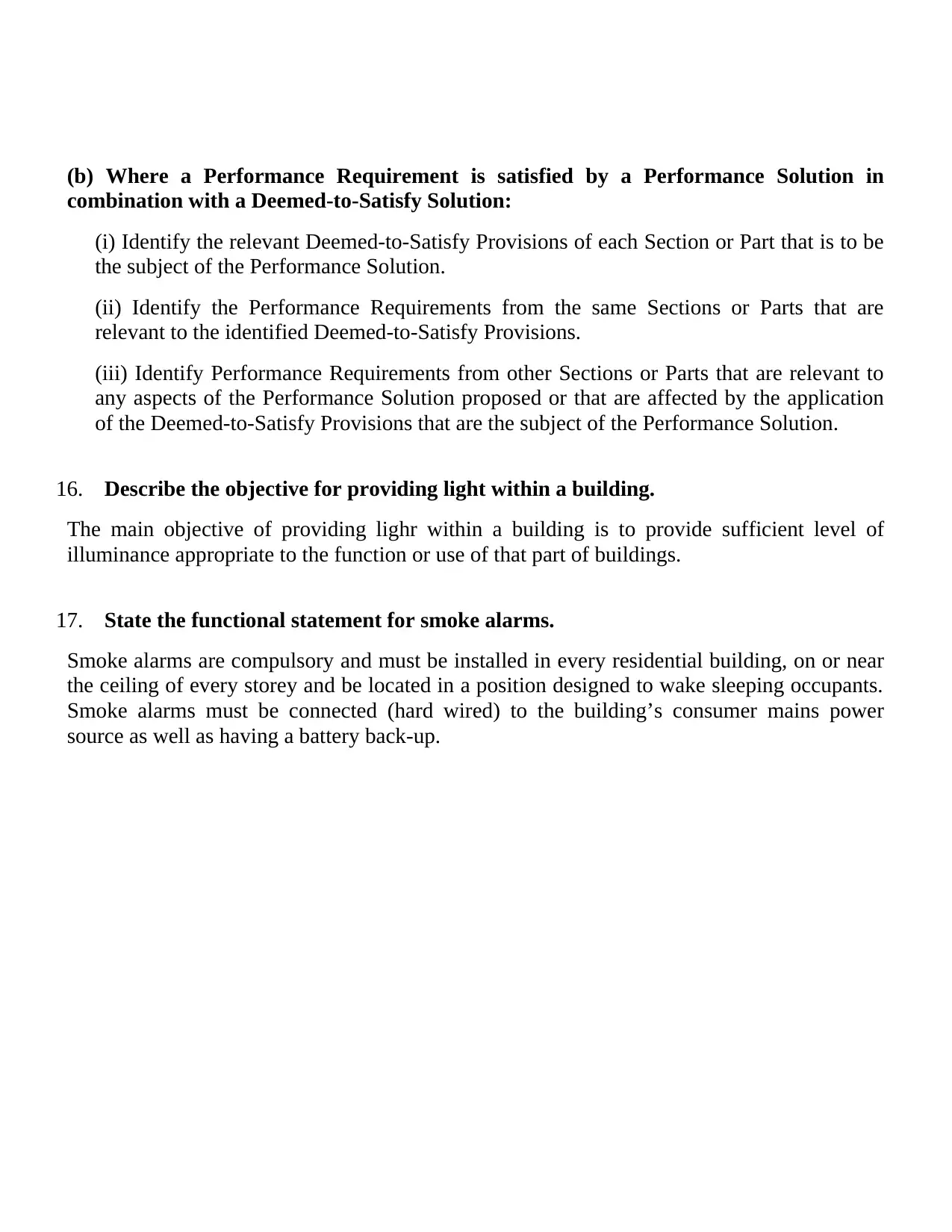
(b) Where a Performance Requirement is satisfied by a Performance Solution in
combination with a Deemed-to-Satisfy Solution:
(i) Identify the relevant Deemed-to-Satisfy Provisions of each Section or Part that is to be
the subject of the Performance Solution.
(ii) Identify the Performance Requirements from the same Sections or Parts that are
relevant to the identified Deemed-to-Satisfy Provisions.
(iii) Identify Performance Requirements from other Sections or Parts that are relevant to
any aspects of the Performance Solution proposed or that are affected by the application
of the Deemed-to-Satisfy Provisions that are the subject of the Performance Solution.
16. Describe the objective for providing light within a building.
The main objective of providing lighr within a building is to provide sufficient level of
illuminance appropriate to the function or use of that part of buildings.
17. State the functional statement for smoke alarms.
Smoke alarms are compulsory and must be installed in every residential building, on or near
the ceiling of every storey and be located in a position designed to wake sleeping occupants.
Smoke alarms must be connected (hard wired) to the building’s consumer mains power
source as well as having a battery back-up.
combination with a Deemed-to-Satisfy Solution:
(i) Identify the relevant Deemed-to-Satisfy Provisions of each Section or Part that is to be
the subject of the Performance Solution.
(ii) Identify the Performance Requirements from the same Sections or Parts that are
relevant to the identified Deemed-to-Satisfy Provisions.
(iii) Identify Performance Requirements from other Sections or Parts that are relevant to
any aspects of the Performance Solution proposed or that are affected by the application
of the Deemed-to-Satisfy Provisions that are the subject of the Performance Solution.
16. Describe the objective for providing light within a building.
The main objective of providing lighr within a building is to provide sufficient level of
illuminance appropriate to the function or use of that part of buildings.
17. State the functional statement for smoke alarms.
Smoke alarms are compulsory and must be installed in every residential building, on or near
the ceiling of every storey and be located in a position designed to wake sleeping occupants.
Smoke alarms must be connected (hard wired) to the building’s consumer mains power
source as well as having a battery back-up.
Paraphrase This Document
Need a fresh take? Get an instant paraphrase of this document with our AI Paraphraser
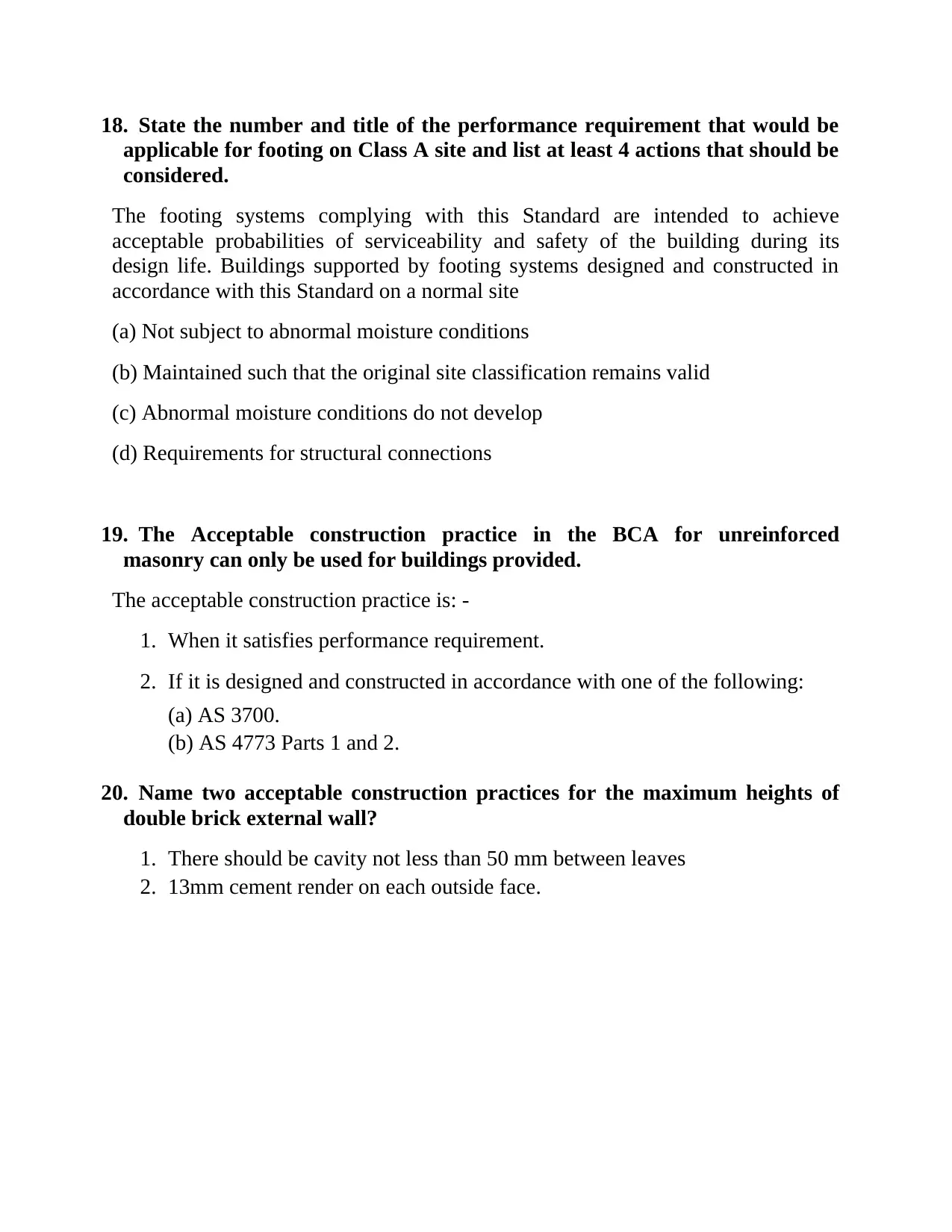
18. State the number and title of the performance requirement that would be
applicable for footing on Class A site and list at least 4 actions that should be
considered.
The footing systems complying with this Standard are intended to achieve
acceptable probabilities of serviceability and safety of the building during its
design life. Buildings supported by footing systems designed and constructed in
accordance with this Standard on a normal site
(a) Not subject to abnormal moisture conditions
(b) Maintained such that the original site classification remains valid
(c) Abnormal moisture conditions do not develop
(d) Requirements for structural connections
19. The Acceptable construction practice in the BCA for unreinforced
masonry can only be used for buildings provided.
The acceptable construction practice is: -
1. When it satisfies performance requirement.
2. If it is designed and constructed in accordance with one of the following:
(a) AS 3700.
(b) AS 4773 Parts 1 and 2.
20. Name two acceptable construction practices for the maximum heights of
double brick external wall?
1. There should be cavity not less than 50 mm between leaves
2. 13mm cement render on each outside face.
applicable for footing on Class A site and list at least 4 actions that should be
considered.
The footing systems complying with this Standard are intended to achieve
acceptable probabilities of serviceability and safety of the building during its
design life. Buildings supported by footing systems designed and constructed in
accordance with this Standard on a normal site
(a) Not subject to abnormal moisture conditions
(b) Maintained such that the original site classification remains valid
(c) Abnormal moisture conditions do not develop
(d) Requirements for structural connections
19. The Acceptable construction practice in the BCA for unreinforced
masonry can only be used for buildings provided.
The acceptable construction practice is: -
1. When it satisfies performance requirement.
2. If it is designed and constructed in accordance with one of the following:
(a) AS 3700.
(b) AS 4773 Parts 1 and 2.
20. Name two acceptable construction practices for the maximum heights of
double brick external wall?
1. There should be cavity not less than 50 mm between leaves
2. 13mm cement render on each outside face.
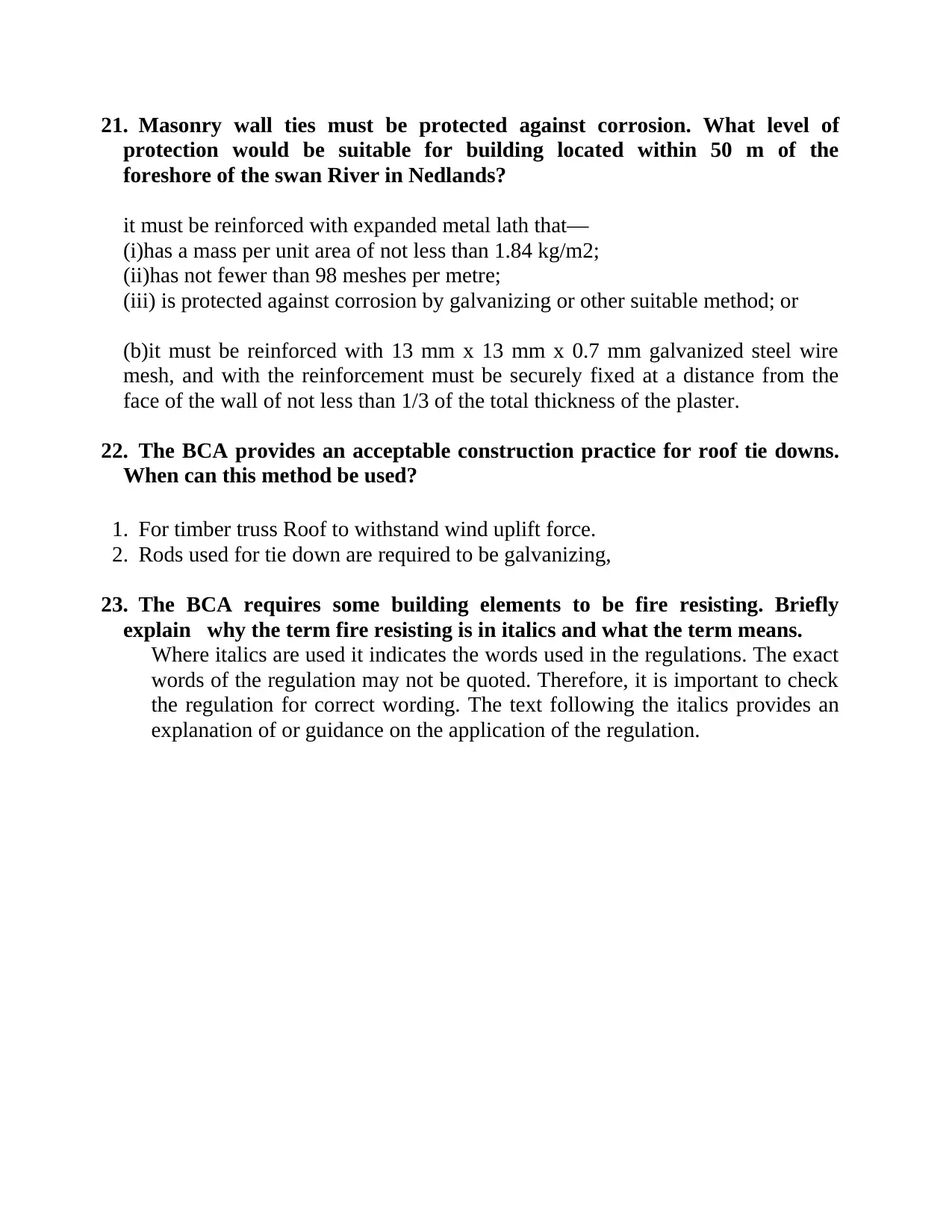
21. Masonry wall ties must be protected against corrosion. What level of
protection would be suitable for building located within 50 m of the
foreshore of the swan River in Nedlands?
it must be reinforced with expanded metal lath that—
(i)has a mass per unit area of not less than 1.84 kg/m2;
(ii)has not fewer than 98 meshes per metre;
(iii) is protected against corrosion by galvanizing or other suitable method; or
(b)it must be reinforced with 13 mm x 13 mm x 0.7 mm galvanized steel wire
mesh, and with the reinforcement must be securely fixed at a distance from the
face of the wall of not less than 1/3 of the total thickness of the plaster.
22. The BCA provides an acceptable construction practice for roof tie downs.
When can this method be used?
1. For timber truss Roof to withstand wind uplift force.
2. Rods used for tie down are required to be galvanizing,
23. The BCA requires some building elements to be fire resisting. Briefly
explain why the term fire resisting is in italics and what the term means.
Where italics are used it indicates the words used in the regulations. The exact
words of the regulation may not be quoted. Therefore, it is important to check
the regulation for correct wording. The text following the italics provides an
explanation of or guidance on the application of the regulation.
protection would be suitable for building located within 50 m of the
foreshore of the swan River in Nedlands?
it must be reinforced with expanded metal lath that—
(i)has a mass per unit area of not less than 1.84 kg/m2;
(ii)has not fewer than 98 meshes per metre;
(iii) is protected against corrosion by galvanizing or other suitable method; or
(b)it must be reinforced with 13 mm x 13 mm x 0.7 mm galvanized steel wire
mesh, and with the reinforcement must be securely fixed at a distance from the
face of the wall of not less than 1/3 of the total thickness of the plaster.
22. The BCA provides an acceptable construction practice for roof tie downs.
When can this method be used?
1. For timber truss Roof to withstand wind uplift force.
2. Rods used for tie down are required to be galvanizing,
23. The BCA requires some building elements to be fire resisting. Briefly
explain why the term fire resisting is in italics and what the term means.
Where italics are used it indicates the words used in the regulations. The exact
words of the regulation may not be quoted. Therefore, it is important to check
the regulation for correct wording. The text following the italics provides an
explanation of or guidance on the application of the regulation.
⊘ This is a preview!⊘
Do you want full access?
Subscribe today to unlock all pages.

Trusted by 1+ million students worldwide
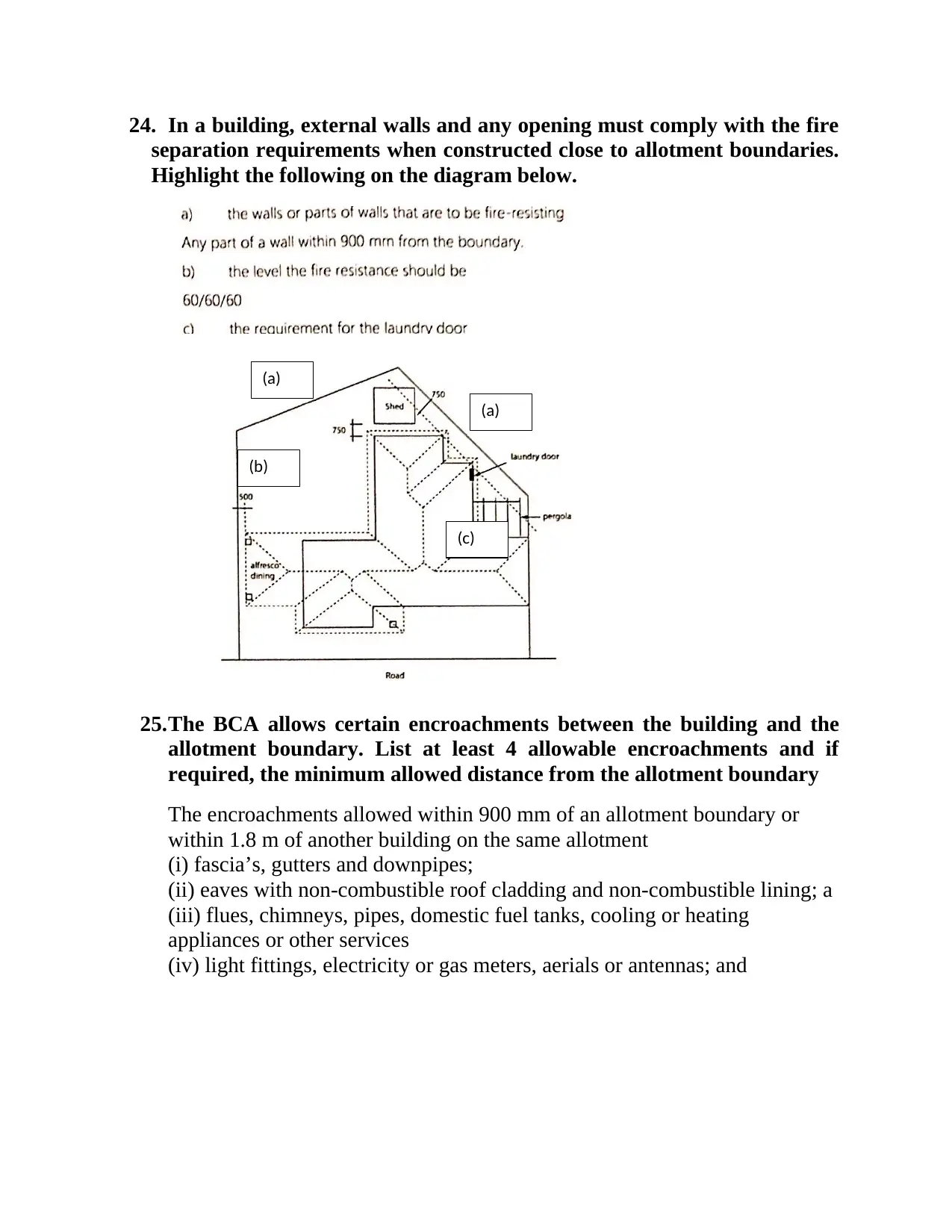
24. In a building, external walls and any opening must comply with the fire
separation requirements when constructed close to allotment boundaries.
Highlight the following on the diagram below.
25.The BCA allows certain encroachments between the building and the
allotment boundary. List at least 4 allowable encroachments and if
required, the minimum allowed distance from the allotment boundary
The encroachments allowed within 900 mm of an allotment boundary or
within 1.8 m of another building on the same allotment
(i) fascia’s, gutters and downpipes;
(ii) eaves with non-combustible roof cladding and non-combustible lining; a
(iii) flues, chimneys, pipes, domestic fuel tanks, cooling or heating
appliances or other services
(iv) light fittings, electricity or gas meters, aerials or antennas; and
(a)
(a)
(b)
(c)
separation requirements when constructed close to allotment boundaries.
Highlight the following on the diagram below.
25.The BCA allows certain encroachments between the building and the
allotment boundary. List at least 4 allowable encroachments and if
required, the minimum allowed distance from the allotment boundary
The encroachments allowed within 900 mm of an allotment boundary or
within 1.8 m of another building on the same allotment
(i) fascia’s, gutters and downpipes;
(ii) eaves with non-combustible roof cladding and non-combustible lining; a
(iii) flues, chimneys, pipes, domestic fuel tanks, cooling or heating
appliances or other services
(iv) light fittings, electricity or gas meters, aerials or antennas; and
(a)
(a)
(b)
(c)
Paraphrase This Document
Need a fresh take? Get an instant paraphrase of this document with our AI Paraphraser
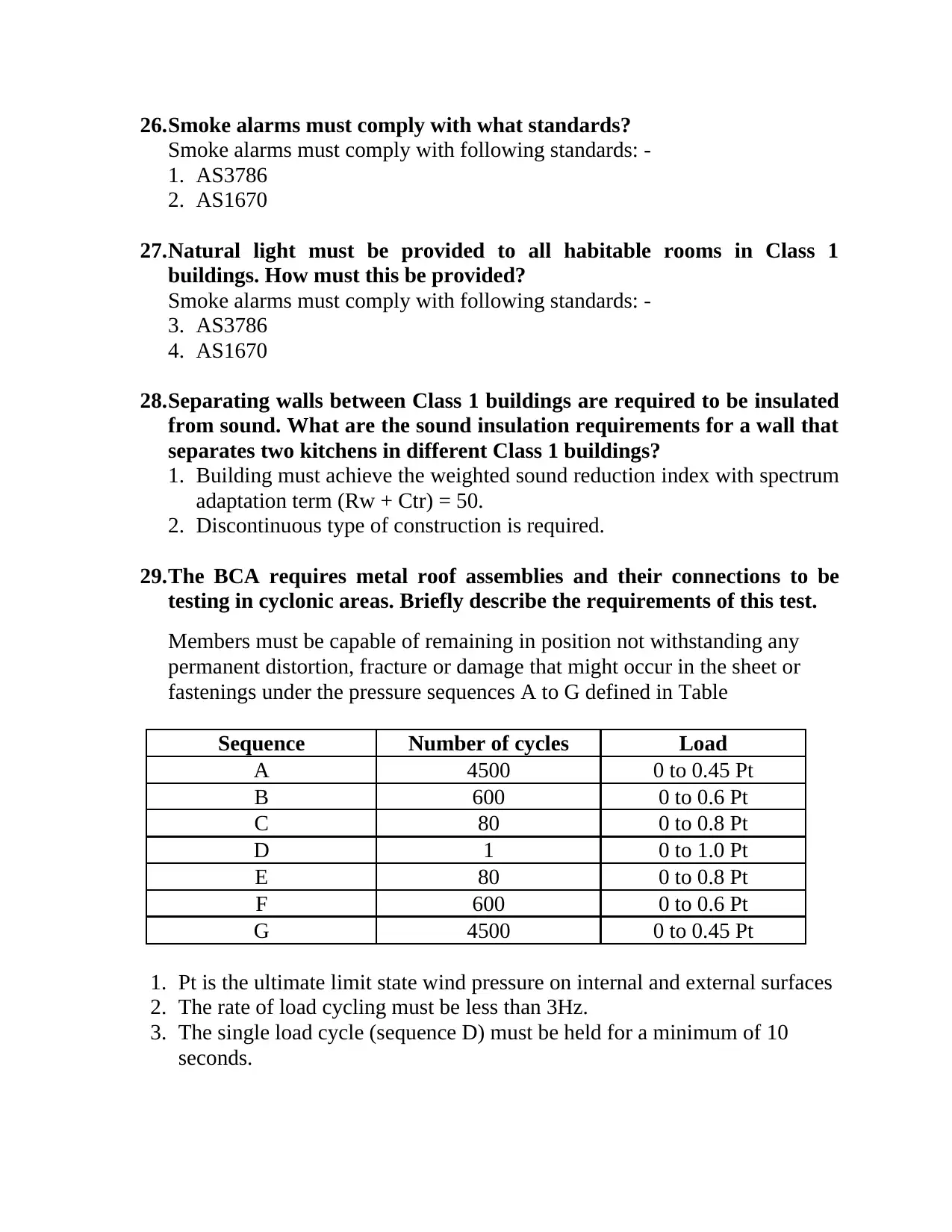
26.Smoke alarms must comply with what standards?
Smoke alarms must comply with following standards: -
1. AS3786
2. AS1670
27.Natural light must be provided to all habitable rooms in Class 1
buildings. How must this be provided?
Smoke alarms must comply with following standards: -
3. AS3786
4. AS1670
28.Separating walls between Class 1 buildings are required to be insulated
from sound. What are the sound insulation requirements for a wall that
separates two kitchens in different Class 1 buildings?
1. Building must achieve the weighted sound reduction index with spectrum
adaptation term (Rw + Ctr) = 50.
2. Discontinuous type of construction is required.
29.The BCA requires metal roof assemblies and their connections to be
testing in cyclonic areas. Briefly describe the requirements of this test.
Members must be capable of remaining in position not withstanding any
permanent distortion, fracture or damage that might occur in the sheet or
fastenings under the pressure sequences A to G defined in Table
Sequence Number of cycles Load
A 4500 0 to 0.45 Pt
B 600 0 to 0.6 Pt
C 80 0 to 0.8 Pt
D 1 0 to 1.0 Pt
E 80 0 to 0.8 Pt
F 600 0 to 0.6 Pt
G 4500 0 to 0.45 Pt
1. Pt is the ultimate limit state wind pressure on internal and external surfaces
2. The rate of load cycling must be less than 3Hz.
3. The single load cycle (sequence D) must be held for a minimum of 10
seconds.
Smoke alarms must comply with following standards: -
1. AS3786
2. AS1670
27.Natural light must be provided to all habitable rooms in Class 1
buildings. How must this be provided?
Smoke alarms must comply with following standards: -
3. AS3786
4. AS1670
28.Separating walls between Class 1 buildings are required to be insulated
from sound. What are the sound insulation requirements for a wall that
separates two kitchens in different Class 1 buildings?
1. Building must achieve the weighted sound reduction index with spectrum
adaptation term (Rw + Ctr) = 50.
2. Discontinuous type of construction is required.
29.The BCA requires metal roof assemblies and their connections to be
testing in cyclonic areas. Briefly describe the requirements of this test.
Members must be capable of remaining in position not withstanding any
permanent distortion, fracture or damage that might occur in the sheet or
fastenings under the pressure sequences A to G defined in Table
Sequence Number of cycles Load
A 4500 0 to 0.45 Pt
B 600 0 to 0.6 Pt
C 80 0 to 0.8 Pt
D 1 0 to 1.0 Pt
E 80 0 to 0.8 Pt
F 600 0 to 0.6 Pt
G 4500 0 to 0.45 Pt
1. Pt is the ultimate limit state wind pressure on internal and external surfaces
2. The rate of load cycling must be less than 3Hz.
3. The single load cycle (sequence D) must be held for a minimum of 10
seconds.

30.List two Acceptable construction manuals for high wind areas that are
reference by BCA.
1. AS/NZS 1170.2
2. AS/NZS 1170.0
reference by BCA.
1. AS/NZS 1170.2
2. AS/NZS 1170.0
⊘ This is a preview!⊘
Do you want full access?
Subscribe today to unlock all pages.

Trusted by 1+ million students worldwide
1 out of 12
Related Documents
Your All-in-One AI-Powered Toolkit for Academic Success.
+13062052269
info@desklib.com
Available 24*7 on WhatsApp / Email
![[object Object]](/_next/static/media/star-bottom.7253800d.svg)
Unlock your academic potential
Copyright © 2020–2025 A2Z Services. All Rights Reserved. Developed and managed by ZUCOL.





